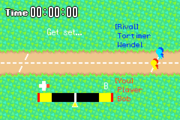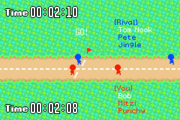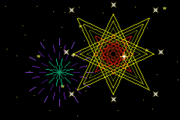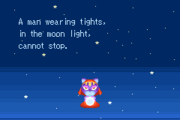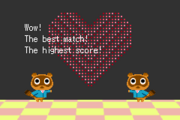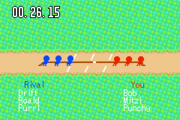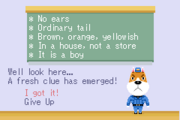Difference between revisions of "E-Reader"
m (Removed protection from "Nintendo e-Reader": Drago was right, vandalism was not excessive) |
Bowserbros (talk | contribs) |
||
| (32 intermediate revisions by 11 users not shown) | |||
| Line 1: | Line 1: | ||
| + | {{DISPLAYTITLE:e-Reader}} | ||
| + | {{Wrongpage|the peripheral itself|information on the Animal Crossing e-Reader cards|e-Reader card}} | ||
{{Infobox System | {{Infobox System | ||
| − | |name= e-Reader | + | |name = e-Reader |
| − | |logo= [[File: | + | |logo= [[File:e-Reader Logo.png|200px]] |
|logosize= | |logosize= | ||
| − | |image= [[File: | + | |image = [[File:e-Reader.jpg|200px]] |
| − | |imagesize= | + | |imagesize = |
|caption= | |caption= | ||
| − | |||
|manufacturer= Nintendo | |manufacturer= Nintendo | ||
| − | | | + | |released= '''Card-e Reader'''<br>{{Flag|JPN}} December 1, 2001<br>'''e-Reader/Card-e Reader+'''<br>{{Flag|USA}} September 16, 2002<ref name=Pojo>http://www.pojo.com/features/May2002/6-05-Ecard.html</ref><br>{{Flag|JPN}} June 27, 2003<br>{{Flag|AUS}} October 31, 2003 |
| − | |||
|media= Game Boy Advance cartridge with built-in link port | |media= Game Boy Advance cartridge with built-in link port | ||
| − | |||
| − | |||
| − | |||
}} | }} | ||
| − | + | The '''e-Reader''' is an add-on for the [[Game Boy Advance]] that can be used to scan [[e-Reader card]]s, which have data encoded on them in a printed dot code. Scanning e-Reader cards can provide the player with minigames or other unique content with an e-Reader alone, or unlock content in existing Game Boy Advance games such as ''[[mariowiki:Super Mario Advance 4: Super Mario Bros. 3|Super Mario Advance 4: Super Mario Bros. 3]]'' by connecting to another GBA. If a GBA with an e-Reader is connected to a [[Nintendo GameCube]], scanning cards can unlock content in certain games such as {{PG}}. | |
| − | The '''e-Reader''' is | ||
| − | e-Reader cards | + | Series of e-Reader cards were released for several Game Boy Advance and GameCube games, including {{DnM+}}, {{PG|nolink}}, and {{DnMe+}}. |
| − | == | + | ==Hardware== |
| − | + | There are three releases of the e-Reader. The original Card-e Reader,{{Note|{{Nihongo foot|カード{{tt|e|イー}}リーダー|Kādo-ī Rīdā|Card-e Reader}}}} released in Japan in December 2001, cannot connect to GameCube or Game Boy Advance games. This feature, alongside the ability to save scanned software, was added to the North American e-Reader, which was released alongside {{PG}} on September 16, 2002. An enhanced model featuring the improvements from the North American model was later brought to Japan in the Card-e Reader+,{{Note|{{Nihongo foot|カード{{tt|e|イー}}リーダー{{tt|+|プラス}}|Kādo-ī Rīdā Purasu|Card-e Reader+}}}} which was released on June 27, 2003, alongside {{DnMe+}} and bundled with all copies of the game. In October 2003, the e-Reader was released in Australia and has identical hardware to its North American variant. | |
| − | + | The e-Reader slots into the Game Boy Advance like a standard cartridge. On original GBA models, the accessory obstructs the Link Cable port, so the North American e-Reader and Card-e Reader+ also plug into the port to provide a passthrough connection to allow for GBA–GameCube and GBA–GBA connectivity. On Game Boy Advance SP systems, the Link Cable port is not obstructed, so the passthrough connection is not necessary. The e-Reader is not fully compatible with the Game Boy Micro, Nintendo DS, or Nintendo DS Lite. On the Game Boy Micro and Nintendo DS, the Link Cable connector prevents the e-Reader from fitting into the system; since the original Japanese Card-e Reader does not have a Link Cable connecter, it can fit in these consoles. The e-Reader can fit in a Nintendo DS Lite but cannot be connected to another GBA or a GameCube due to a lack of a Link Cable port on Nintendo DS systems. | |
| − | |||
| − | + | e-Reader cards hold their data in a proprietary dot code strip, which contains up to 2.2 KB of compressed and encrypted data. For more data, cards can have up to two dot code strips, and data can be spread across multiple cards. The dot codes are read by swiping them across an optical sensor on the e-Reader. The data on e-Reader cards is encoded to either North America or Japan and can only be scanned by an e-Reader of the same region. | |
| − | |||
| − | |||
| − | |||
| − | == References == | + | ==''Animal Crossing'' connectivity== |
| + | :''<span class="noprint"><span class="theme-text" style="font-family: 'Coustard','Linux Libertine',Georgia,Times,serif; font-weight: 130;">Further information:</span></span> [[e-Reader card]]'' | ||
| + | Across {{DnM+|nolink}}, {{PG|nolink}}, and {{DnMe+|nolink}}, a total of 454 unique (771 counting regional variants) ''Animal Crossing'' e-Reader cards were released from 2002 to 2003. There are cards for every [[villager]] and [[special character]], which make up the vast majority of cards and offer the player items in the GameCube games. Additionally, there are several other card types, including Design Cards, Town Tune Cards, Game Cards, Sibling Cards, and Classic Game Cards. | ||
| + | |||
| + | ==={{DnM+|nolink}}=== | ||
| + | Four series of e-Reader cards ('''''Doubutsu no Mori+ Card-e'''''){{Note|{{Nihongo foot|どうぶつの森{{tt|+|プラス}} カード{{tt|e|イー}}|Doubutsu no Mori Purasu Kādo-ī|Animal Forest+ Card-e}}}} were released for {{DnM+}} throughout 2002. Due to the original Japanese Card-e Reader's lack of Nintendo GameCube connectivity, {{DnM+}} has no direct compatibility with the e-Reader; however, scanning Character Cards or Game Cards can give the player [[secret code]]s that can then be used in-game to receive various items. | ||
| + | |||
| + | ==={{PG|nolink}}=== | ||
| + | Four series of e-Reader cards ('''''Animal Crossing-e''''') were released for {{PG}} from 2002 to 2003, with most being localized versions of the previously-released {{DnM+|nolink}} cards. Due to the North American e-Reader's Nintendo GameCube connectivity, cards can be scanned directly in the game. There are three locations where this can be done: the e-Reader Transfer Machine (eTM) in the [[post office]], where Character Cards or Classic Game Cards can be scanned to receive items; the [[town tune]] board outside the post office, where Town Tune Cards can be scanned to set the town's tune to the one on the card; and at the [[Able Sisters]], where Design Cards can be scanned to save the design on the card. | ||
| + | |||
| + | Additionally, Character and Game Cards still give secret codes when scanned on the e-Reader by itself, which can be used in-game to receive various items. | ||
| + | |||
| + | Since the e-Reader was never released in Europe, all e-Reader functionality was removed from the European version of {{PG|nolink}}. Since the secret code system is unchanged, any codes from e-Reader cards are still functional. | ||
| + | |||
| + | ==={{DnMe+|nolink}}=== | ||
| + | Three series of e-Reader cards ('''''Doubutsu no Mori Card-e+'''''){{Note|{{Nihongo foot|どうぶつの森 カード{{tt|e+|イープラス}}|Doubutsu no Mori Kādo-ī Purasu|Animal Forest Card-e+}}}} were released for {{DnMe+}} in 2003, with cards being made for every new villager and islander alongside new Town Tune and Design Cards. The Card-e Reader+ was bundled with all copies of the game alongside the first six cards of Series 1. | ||
| + | |||
| + | All e-Reader functionality from {{PG|nolink}} is retained, alongside some new functionality. Character Cards can now be scanned at the [[wishing well]] to have the villager on the card move in, or in the case of islanders, wash ashore on [[Animal Island]]. This is the only way for any of the new villagers to move in, and the only way for any islander to appear on the island, as the characters are written into reserved blank space in the player's save file using information stored on the cards' dot code strips.<ref>{{Cite web|author=Hunter R.|date=November 20, 2024|url=https://www.youtube.com/watch?v=V1d8XWf8dDk|title=Creating e-Reader Villagers in Animal Crossing|site=YouTube|retrieved=November 24, 2024}}</ref> Town Tune Cards also have new functionality: scanning one of the new [[K.K. Slider songs|K.K. Slider song's]] cards unlocks them for K.K. to play and unlocks a live aircheck of that song which can be obtained by speaking to a specific special character. | ||
| + | |||
| + | {{DnMe+|nolink}} is also compatible with {{DnM+|nolink}} cards. Using any e-Reader secret code from a {{DnM+|nolink}} card results in the player receiving either the {{I|decorative plate|DnMe+}}, {{I|shop signboard|DnMe+}}, or {{I|Tom Nook's autograph card|DnMe+}} instead of the secret code's normal item. | ||
| + | |||
| + | ==List of games== | ||
| + | There are eight standalone e-Reader minigames contained on {{DnM+}} and {{PG}} Game Cards. Each game has an A and B variant,{{Note|''Animal Relay'' and ''Fortune Telling'' also have "SP" versions that were only released in Japan.}} with slight differences between the two. The gameplay consist of scanning a certain number of Character Cards, and if certain criteria are met in each game, a secret code is given that can be used in the GameCube games. | ||
| + | |||
| + | <gallery widths=200> | ||
| + | AC-e 3-Legged Race Gameplay.png|''[[3-Legged Race]]'' | ||
| + | AC-e Animal Jumprope A Gameplay.png|''[[Animal Jumprope]]'' | ||
| + | AC-e Animal Relay Gameplay.png|''[[Animal Relay]]'' | ||
| + | AC-e Fireworks Show Gameplay.png|''[[Fireworks Show (minigame)|Fireworks Show]]'' | ||
| + | AC-e Fortune Telling Gameplay.png|''[[Fortune Telling]]'' | ||
| + | AC-e Matchmakers 4.png|''[[Matchmakers]]'' | ||
| + | AC-e Tug of War Gameplay.png|''[[Tug of War]]'' | ||
| + | AC-e Who's Dunnit A Gameplay.png|''[[Who's Dunnit?]]'' | ||
| + | </gallery> | ||
| + | |||
| + | ==Notes== | ||
| + | {{Note list}} | ||
| + | |||
| + | ==References== | ||
{{Reflist}} | {{Reflist}} | ||
| − | |||
| − | |||
| − | [[Category: | + | {{Navbox System and Peripherals}} |
| − | [[Category: | + | [[Category:Game Boy Advance]] |
| + | [[Category:e-Reader|*]] | ||
Latest revision as of 16:46, November 24, 2024
| ||||||
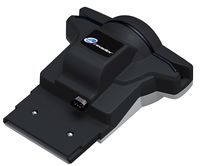 | ||||||
| Manufacturer | Nintendo | |||||
|---|---|---|---|---|---|---|
| Release date(s) | Card-e Reader e-Reader/Card-e Reader+ | |||||
| Media | Game Boy Advance cartridge with built-in link port | |||||
The e-Reader is an add-on for the Game Boy Advance that can be used to scan e-Reader cards, which have data encoded on them in a printed dot code. Scanning e-Reader cards can provide the player with minigames or other unique content with an e-Reader alone, or unlock content in existing Game Boy Advance games such as Super Mario Advance 4: Super Mario Bros. 3 by connecting to another GBA. If a GBA with an e-Reader is connected to a Nintendo GameCube, scanning cards can unlock content in certain games such as Animal Crossing.
Series of e-Reader cards were released for several Game Boy Advance and GameCube games, including Doubutsu no Mori+, Animal Crossing, and Doubutsu no Mori e+.
Hardware[edit]
There are three releases of the e-Reader. The original Card-e Reader,[nb 1] released in Japan in December 2001, cannot connect to GameCube or Game Boy Advance games. This feature, alongside the ability to save scanned software, was added to the North American e-Reader, which was released alongside Animal Crossing on September 16, 2002. An enhanced model featuring the improvements from the North American model was later brought to Japan in the Card-e Reader+,[nb 2] which was released on June 27, 2003, alongside Doubutsu no Mori e+ and bundled with all copies of the game. In October 2003, the e-Reader was released in Australia and has identical hardware to its North American variant.
The e-Reader slots into the Game Boy Advance like a standard cartridge. On original GBA models, the accessory obstructs the Link Cable port, so the North American e-Reader and Card-e Reader+ also plug into the port to provide a passthrough connection to allow for GBA–GameCube and GBA–GBA connectivity. On Game Boy Advance SP systems, the Link Cable port is not obstructed, so the passthrough connection is not necessary. The e-Reader is not fully compatible with the Game Boy Micro, Nintendo DS, or Nintendo DS Lite. On the Game Boy Micro and Nintendo DS, the Link Cable connector prevents the e-Reader from fitting into the system; since the original Japanese Card-e Reader does not have a Link Cable connecter, it can fit in these consoles. The e-Reader can fit in a Nintendo DS Lite but cannot be connected to another GBA or a GameCube due to a lack of a Link Cable port on Nintendo DS systems.
e-Reader cards hold their data in a proprietary dot code strip, which contains up to 2.2 KB of compressed and encrypted data. For more data, cards can have up to two dot code strips, and data can be spread across multiple cards. The dot codes are read by swiping them across an optical sensor on the e-Reader. The data on e-Reader cards is encoded to either North America or Japan and can only be scanned by an e-Reader of the same region.
Animal Crossing connectivity[edit]
Across Doubutsu no Mori+, Animal Crossing, and Doubutsu no Mori e+, a total of 454 unique (771 counting regional variants) Animal Crossing e-Reader cards were released from 2002 to 2003. There are cards for every villager and special character, which make up the vast majority of cards and offer the player items in the GameCube games. Additionally, there are several other card types, including Design Cards, Town Tune Cards, Game Cards, Sibling Cards, and Classic Game Cards.
Doubutsu no Mori+[edit]
Four series of e-Reader cards (Doubutsu no Mori+ Card-e)[nb 3] were released for Doubutsu no Mori+ throughout 2002. Due to the original Japanese Card-e Reader's lack of Nintendo GameCube connectivity, Doubutsu no Mori+ has no direct compatibility with the e-Reader; however, scanning Character Cards or Game Cards can give the player secret codes that can then be used in-game to receive various items.
Animal Crossing[edit]
Four series of e-Reader cards (Animal Crossing-e) were released for Animal Crossing from 2002 to 2003, with most being localized versions of the previously-released Doubutsu no Mori+ cards. Due to the North American e-Reader's Nintendo GameCube connectivity, cards can be scanned directly in the game. There are three locations where this can be done: the e-Reader Transfer Machine (eTM) in the post office, where Character Cards or Classic Game Cards can be scanned to receive items; the town tune board outside the post office, where Town Tune Cards can be scanned to set the town's tune to the one on the card; and at the Able Sisters, where Design Cards can be scanned to save the design on the card.
Additionally, Character and Game Cards still give secret codes when scanned on the e-Reader by itself, which can be used in-game to receive various items.
Since the e-Reader was never released in Europe, all e-Reader functionality was removed from the European version of Animal Crossing. Since the secret code system is unchanged, any codes from e-Reader cards are still functional.
Doubutsu no Mori e+[edit]
Three series of e-Reader cards (Doubutsu no Mori Card-e+)[nb 4] were released for Doubutsu no Mori e+ in 2003, with cards being made for every new villager and islander alongside new Town Tune and Design Cards. The Card-e Reader+ was bundled with all copies of the game alongside the first six cards of Series 1.
All e-Reader functionality from Animal Crossing is retained, alongside some new functionality. Character Cards can now be scanned at the wishing well to have the villager on the card move in, or in the case of islanders, wash ashore on Animal Island. This is the only way for any of the new villagers to move in, and the only way for any islander to appear on the island, as the characters are written into reserved blank space in the player's save file using information stored on the cards' dot code strips.[2] Town Tune Cards also have new functionality: scanning one of the new K.K. Slider song's cards unlocks them for K.K. to play and unlocks a live aircheck of that song which can be obtained by speaking to a specific special character.
Doubutsu no Mori e+ is also compatible with Doubutsu no Mori+ cards. Using any e-Reader secret code from a Doubutsu no Mori+ card results in the player receiving either the decorative plate, shop signboard, or Tom Nook's autograph card instead of the secret code's normal item.
List of games[edit]
There are eight standalone e-Reader minigames contained on Doubutsu no Mori+ and Animal Crossing Game Cards. Each game has an A and B variant,[nb 5] with slight differences between the two. The gameplay consist of scanning a certain number of Character Cards, and if certain criteria are met in each game, a secret code is given that can be used in the GameCube games.
Notes[edit]
- ↑ Japanese: カードeリーダー Hepburn: Kādo-ī Rīdā, Card-e Reader
- ↑ Japanese: カードeリーダー+ Hepburn: Kādo-ī Rīdā Purasu, Card-e Reader+
- ↑ Japanese: どうぶつの森+ カードe Hepburn: Doubutsu no Mori Purasu Kādo-ī, Animal Forest+ Card-e
- ↑ Japanese: どうぶつの森 カードe+ Hepburn: Doubutsu no Mori Kādo-ī Purasu, Animal Forest Card-e+
- ↑ Animal Relay and Fortune Telling also have "SP" versions that were only released in Japan.
References[edit]
- ↑ http://www.pojo.com/features/May2002/6-05-Ecard.html
- ↑ Hunter R. (November 20, 2024). "Creating e-Reader Villagers in Animal Crossing". YouTube. Retrieved November 24, 2024.
| Nintendo video game consoles | ||||||||||||||
|---|---|---|---|---|---|---|---|---|---|---|---|---|---|---|
| ||||||||||||||

